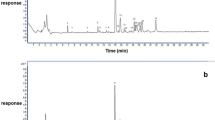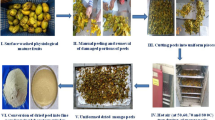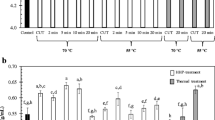Abstract
Vegetable wastes are generated during harvesting, processing, and distribution, which implies a wastage of nutrients and evidence inefficiencies in present food systems. Vegetable residues are rich in bioactive compounds, for which their valorisation and reintroduction into the food chain are crucial towards circular economy and food systems sustainability. In this work, upcycled powdered ingredients were obtained from vegetables wastes (carrot, white cabbage, celery, and leek) through a disruption, dehydration and milling process. Disruption pre-treatment at different intensities was followed by freeze-drying or hot-air drying (60 and 70 °C), and final milling to produce fine powders. Powdered products were characterized in terms of physicochemical, antioxidant and technological properties (water and oil interaction), after processing and during four months of storage. Antioxidant properties were generally favoured by hot-air drying, particularly at 70 °C, attributed to new compounds formation combined to less exposure time to drying conditions. The powders showed good water interaction properties, especially freeze-dried ones. Storage had a negative impact on the quality of powders: moisture increased, antioxidant compounds generally diminished, and colour changes were evidenced. Upcycled vegetable waste powders are proposed as ingredients to fortify foods, both processing and storage conditions having an impact on their properties.




Similar content being viewed by others
Data Availability
Data supporting the findings of this study are available upon reasonable request.
References
FAO and the Sustainable Development Goals (2023) FAO. Food and Agriculture Organization of the United Nations. https://www.fao.org/about/strategy-programme-budget/strategic-framework/fao-sdg/en/ (Accessed 26th
Henríquez C, Córdova A, Lutz M, Saavedra J (2004) Storage stability test of apple peel powder using two packaging materials: high-density polyethylene and metalized films of high barrier. Ind Crops Prod 45:121–127. https://doi.org/10.1016/j.indcrop.2012.11.032
Korus A (2011) Effect of preliminary processing, method of drying and storage temperature on the level of antioxidants in kale (Brassica oleracea L var. Acephala) leaves. LWT-Food Sci Technol 44(8):1711–1716. https://doi.org/10.1016/j.lwt.2011.03.014
Neacsu M, Vaughan N, Raikos V et al (2015) Phytochemical profile of commercially available food plant powders: their potential role in healthier food reformulations. Food Chem 179:159–169. https://doi.org/10.1016/j.foodchem.2015.01.128
Ramírez-Pulido B, Bas-Bellver C, Betoret N, Barrera C, Seguí L (2021) Valorization of vegetable fresh-processing residues as functional powdered ingredients. A review on the potential impact of pretreatments and drying methods on Bioactive compounds and their bioaccessibility. Front Sustain Food Syst 5:82. https://doi.org/10.3389/fsufs.2021.654313
Chen ML, Yang DJ, Liu SC (2011) Effects of drying temperature on the flavonoid, phenolic acid and antioxidative capacities of the methanol extract of citrus fruit (Citrus sinensis (L.) Osbeck) peels. Int J Food Sci Technol 46(6):1179–1185. https://doi.org/10.1111/j.1365-2621.2011.02605.x
Mrkìc V, Cocci E, Dalla Rosa M, Sacchetti G (2006) Effect of drying conditions on bioactive compounds and antioxidant activity of broccoli (Brassica oleracea L). J Sci Food Agric 86(10):1559–1566. https://doi.org/10.1002/jsfa.2554
Djantou EB, Mbofung CMF, Scher J, Phambu N, Morael JD (2011) Alternation drying and grinding (ADG) technique: a novel approach for producing ripe mango powder. LWT-Food Sci Technol 44(7):1585–1590. https://doi.org/10.1016/j.lwt.2011.01.022
Bas-Bellver C, Barrera C, Betoret N, Seguí L (2020) Turning agri-food cooperative vegetable residues into functional powdered ingredients for the food industry. Sustainability 12:1284. https://doi.org/10.3390/su12041284
Bernaert N, de Clercq H, van Bockstaele E et al (2013) Antioxidant changes during postharvest processing and storage of leek (Allium ampeloprasum var. porrum). Postharvest Biol Technol 86:8–16. https://doi.org/10.1016/j.postharvbio.2013.06.010
Bas-Bellver C, Barrera C, Betoret N, Seguí L (2022) Impact of disruption and drying conditions on physicochemical, functional and antioxidant properties of powdered ingredients obtained from Brassica vegetable by-products. Foods 11(22):3663. https://doi.org/10.3390/foods11223663
Gulati T, Datta AK (2015) Mechanistic understanding of case-hardening and texture development during drying of food materials. J Food Eng 166:119–138. https://doi.org/10.1016/j.jfoodeng.2015.05.031
Santos PHS, Silva MA (2008) Retention of vitamin C in drying processes of fruits and vegetables—A review. Rev Dry Technol 26(129):1421–1437. https://doi.org/10.1080/07373930802458911
Chevalier W, Moussa SA, Ottoni MMN et al (2022) Evaluation of pedoclimatic factors and cultural practices effects on carotenoid and sugar content in carrot root. Eur J Agron 140:126577. https://doi.org/10.1016/j.eja.2022.126577
Miletic N, Mitrovic O, Popovic B et al (2013) Polyphenolic content and antioxidant capacity in fruits of plum (Prunus domestica L.) cultivars ‘Valjevka’ and ‘Mildora’ as influenced by air drying. J Food Qual 36:229–237. https://doi.org/10.1111/jfq.12035
Márquez-Cardozo CJ, Caballero-Gutiérrez BL, Ciro-Velázquez HJ, Restrepo-Molina HA (2021) Effect of pretreatment and temperature on the drying kinetics and physicochemical and techno-functional characteristics of pumpkin (Cucurbita maxima). Heliyon 7(4):e06802. https://doi.org/10.1016/j.heliyon.2021.e06802
Raja KS, Taip FS, Azmi MMZ, Shishir MRI (2019) Effect of pre-treatment and different drying methods on the physicochemical properties of Carica papaya L. leaf powder. J Saudi Soc Agric Sci 18(2):150–156. https://doi.org/10.1016/j.jssas.2017.04.001
Xu Y, Xiao Y, Lagnika C et al (2020) A comparative evaluation of nutritional properties, antioxidant capacity and physical characteristics of cabbage (Brassica oleracea var. Capitate var L.) subjected to different drying methods. Food Chem 309:124935. https://doi.org/10.1016/j.foodchem.2019.06.002
Vargas L, Kapoor R, Nemzer B, Feng H (2022) Application of different drying methods for evaluation of phytochemical content and physical properties of broccoli, kale, and spinach. LWT-Food Sci Technol 155(1):112892. https://doi.org/10.1016/j.lwt.2021.112892
Calabuig-Jiménez L, Hinestroza-Córdoba LI, Barrera C, Seguí L, Betoret N (2022) Effects of processing and storage conditions on functional properties of powdered blueberry pomace. Sustainability 14(3):1839. https://doi.org/10.3390/su14031839
Si X, Chen Q, Bi J et al (2016) Comparison of different drying methods on the physical properties, bioactive compounds and antioxidant activity of raspberry powders. J Sci Food Agric 96(6):2055–2062. https://doi.org/10.1002/jsfa.7317
Serna-Cock L, Torres-León C, Ayala-Aponte A (2015) Evaluation of food powders obtained from peels of mango (Mangifera indica) as sources of functional ingredients. Información tecnológica 26(2):41–50. https://doi.org/10.4067/S0718-07642015000200006
Martínez-Las Heras R, Landines EF, Heredia A, Castelló ML, Andrés A (2017) Influence of drying process and particle size of persimmon fibre on its physicochemical, antioxidant, hydration and emulsifying properties. J Food Sci Technol 54(9):2902–2912. https://doi.org/10.1007/s13197-017-2728-z
Sahni P, Shere DM (2017) Comparative evaluation of physico-chemical and functional properties of apple, carrot and beetroot pomace powders. Int J Food Ferment Technol 7(2):317–323. https://doi.org/10.5958/2321-5771.2017.00043.6
Mokhtar SM, Swailam HM, Embaby HES (2018) Physicochemical properties, nutritional value and techno-functional properties of goldenberry (Physalis peruviana) waste powder. Food Chem 248:1–7. https://doi.org/10.1016/j.foodchem.2017.11.117
Viuda-Martos M, Barber X, Pérez-Álvarez JA, Fernández-López J (2015) Assessment of chemical, physico-chemical, techno-functional and antioxidant properties of fig (Ficus carica L.) powder co-products. Ind Crops Prod 69:472–479. https://doi.org/10.1016/j.indcrop.2015.03.005
Du J, Ge ZZ, Xu Z et al (2014) Comparison of the efficiency of five different drying carriers on the spray drying of persimmon pulp powders. Dry Technol 32(10):1157–1166. https://doi.org/10.1080/07373937.2014.886259
Fernández-López J, Sendra-Nadal E, Navarro C et al (2009) Storage stability of a high dietary fibre powder from orange by-products. Int J Food Sci Technol 44(4):748–756. https://doi.org/10.3390/foods12010159
Dhiman AK, Vidiya N, Surekha A, Preethi R (2017) Studies on development and storage stability of dehydrated pumpkin based instant soup mix. J Appl Nat Sci 9(3):1815–1820. https://doi.org/10.31018/jans.v9i3.1444
Sharma KD, Karki S, Thakur NS, Attri S (2011) Chemical composition, functional properties and processing of carrot-a review. J Food Sci Technol 49(1):22–32. https://doi.org/10.1007/s13197-011-0310-7
Chang LS, Karim R, Abdulkarim SM et al (2018) Storage stability, color kinetics and morphology of spray-dried soursop (Annonaï muricata L) powder: effect of anticaking agents. Int J Food Prop 21(1):1937–1954. https://doi.org/10.1080/10942912.2018.1510836
Liu F, Cao X, Wang H, Liao X (2010) Changes of tomato powder qualities during storage. Powder Technol 204(1):159–166. https://doi.org/10.1016/j.powtec.2010.08.002
Tavares IM, Sumere BR, Gómez-Alonso S et al (2020) Storage stability of the phenolic compounds, color and antioxidant activity of jambolan juice powder obtained by foam mat drying. Food Res Int 128:108750. https://doi.org/10.1016/j.foodres.2019.108750
Michalczyk M, MacUra R, Matuszak I (2009) The effect of air-drying, freeze-drying and storage on the quality and antioxidant activity of some selected berries. J Food Process Preserv 33(1):11–21. https://doi.org/10.1111/j.1745-4549.2008.00232.x
del Caro A, Piga A, Pinna I, Fenu PM, Agabbio M (2004) Effect of drying conditions and storage period on polyphenolic content, antioxidant capacity, and ascorbic acid of prunes. J Agric Food Chem 52(15):4780–4784. https://doi.org/10.1021/jf049889j
Acknowledgements
Authors would like to acknowledge Generalitat Valenciana for funding and Agricola Villena Coop. V. for their participation.
Funding
This research was funded by the regional government of Valencia (Generalitat Valenciana) under the Rural Development Program 2014–2020, and the Spanish Ministry of Agriculture, fisheries and food, under the European Agricultural Fund for Rural Development. Grant number AGCOOP_D/2018/025.
Author information
Authors and Affiliations
Contributions
LS, CB and NB contributed to the conception and design of the work. CBB performed the experimental work under the supervision of LS and CB. LS, CB and NB contributed to funding acquisition. LS, CB and CBB performed the analysis and interpretation of data. CBB draft the paper. LS wrote and edit the final version of the paper. The paper was revised and approved by LS, CB and NB.
Corresponding author
Ethics declarations
Conflict of Interest
The authors declare no conflict of interest.
Ethical Approval and Consent to Participate
Not applicable.
Consent for Publication
Not applicable.
Competing Interests
The authors declare no competing interests.
Additional information
Publisher’s Note
Springer Nature remains neutral with regard to jurisdictional claims in published maps and institutional affiliations.
Electronic Supplementary Material
Below is the link to the electronic supplementary material.




Rights and permissions
Springer Nature or its licensor (e.g. a society or other partner) holds exclusive rights to this article under a publishing agreement with the author(s) or other rightsholder(s); author self-archiving of the accepted manuscript version of this article is solely governed by the terms of such publishing agreement and applicable law.
About this article
Cite this article
Bas-Bellver, C., Barrera, C., Betoret, N. et al. Physicochemical, Technological and Functional Properties of Upcycled Vegetable Waste Ingredients as Affected by Processing and Storage. Plant Foods Hum Nutr 78, 710–719 (2023). https://doi.org/10.1007/s11130-023-01114-1
Accepted:
Published:
Issue Date:
DOI: https://doi.org/10.1007/s11130-023-01114-1




